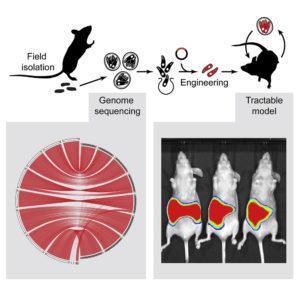Cryptosporidiosis is severe diarrhoeal disease caused by Cryptosporidium sp. that affects many immunocompromised individuals and young children. One of the main challenges of managing Cryptosporidiosis is the lack of an effective treatment nor preventative vaccine. Studies have shown that older children that have had previous disease, develop immunity and experience milder symptoms, suggesting that development of a preventive-vaccination could result in lower cases and improved morbidity.
In humans Cryptosporidium sp. infects the small intestine, while murine cryptosporidium sp. infect the stomach. Further, mice are naturally resistant to infection with human Cryptosporidium sp., as a result developing a murine model that recapitulates human infection is challenging. Sateriale et al., aimed to develop a murine model of Cryptosporidiosis that is similar to human infection and can be used to test potential vaccine strategies.
Sateriale et al., isolated Cryptosporidium tyzzeri from wild mice, and demonstrated that this species is genetically similar (>99%) to human Cryptosporidium sp., colonises the small intestine and causes similar disease pathology. They then used CRISPR technology to engineer reporter parasite strains that enabled visualisation of the parasite in infected tissue and cells. They demonstrated that C.tyzzeri infection of healthy mice is self-resolving, and clears within 21 days post-infection. Once the murine model was established, researchers aimed to determine whether B and T cells were required for parasite clearance. To achieve this, they infected IFN-γ, mature B cell and RAG1 (lacks mature B and T cells) knock out mice with C.tyzzeri. The results of this experiment clearly demonstrated that IFN-γ and T cells, as well as B cells to a lesser extent are required to clear the parasite. Finally, they showed prior infection or “vaccination” with attenuated C.tyzzeri was sufficient to prevent establishment of secondary infection upon challenge.
In summary, Sateriale et al., developed a Cryptosporidiosis murine model using C.tyzzeri sp. that recapitulated human infection, and demonstrated that T cells and IFN-γ production are required to resolve infection and induce protective immunity.
Journal Article: Sateriale et al., 2019. A Genetically Tractable, Natural Mouse Model of Cryptosporidiosis Offers Insights into Host Protective Immunity. Cell Host & Microbe











